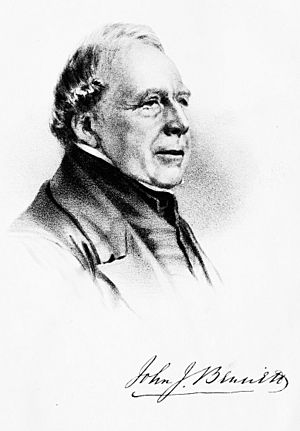John Joseph Bennett facts for kids
Quick facts for kids
John Joseph Bennett
|
|
|---|---|
 |
|
| Born | 8 January 1801 |
| Died | 29 February 1876 |
| Nationality | British |
| Scientific career | |
| Fields | Botany |
| Author abbrev. (botany) | Benn. |
John Joseph Bennett (born January 8, 1801 – died February 29, 1876) was a British doctor and a botanist. Botanists are scientists who study plants. He was the younger brother of Edward Turner Bennett, who studied animals.
Contents
A Life Studying Plants
John Joseph Bennett was born in a place called Tottenham in England. He went to school in Enfield. Later, he studied at Middlesex Hospital and became a doctor in 1825.
He lived with his brother, Edward, in London. They met and helped another scientist named John Edward Gray. Gray even named a plant Bennettia after them! However, it was later found that this plant was actually a type of Saussurea.
Working at the British Museum
In 1827, John Bennett started working at the British Museum. He became an assistant to Robert Brown. Brown was in charge of the amazing plant collection and library that belonged to Joseph Banks, a famous explorer and botanist.
When Robert Brown retired in 1858, John Bennett took over his job. He became the Keeper of the Botanical Department at the British Museum. This was a very important role for someone who loved plants! He retired from the museum in 1870.
Important Science Groups
John Bennett was also part of several important science groups. In 1828, he joined the Linnean Society of London, which is a famous group for natural history. He was the secretary of this society for 20 years, from 1840 to 1860.
In 1841, he became a member of the Royal Society, another very old and respected science group. He also joined the Academy of Sciences Leopoldina in 1864.
Later Life
After retiring from the British Museum, John Bennett moved away from London. He went to live in a quiet place called Maresfield in East Sussex. He passed away there in 1876 from a heart problem. He is buried in the churchyard at Maresfield.
His gravestone has a special message: "He left London, moving away from the world and its worries, to end his days peacefully in his quiet country home." There is also a sculpture of him by an artist named Henry Weekes at the British Museum.
A Big Moment in Science
One of the most famous things John Joseph Bennett did happened on July 1, 1858. He was the secretary of the Linnean Society at the time.
Two very important scientists, Charles Lyell and Joseph Dalton Hooker, gave him some papers. These papers were written by Alfred Russel Wallace and Charles Darwin. They were about a brand new idea called "natural selection".
At a meeting of the Linnean Society, John Bennett read out these papers. This was the first time Darwin and Wallace's ideas about how living things change over time (evolution) were shared with the world!
At first, people didn't pay much attention. But about a year and a half later, Charles Darwin published his famous book, On the Origin of Species. After that, everyone became very interested in the theory of natural selection. John Bennett played a key role in sharing this groundbreaking scientific discovery.
See also
- Publication of Darwin's theory


